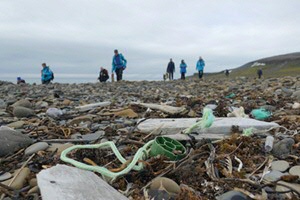A rude awakening
A group of fifty researchers and as many tourists led by Maarten Loonen of the Arctic Centre of the UG is currently sailing around the island of Edgeøya on Spitsbergen. This second Scientific Expedition Edgeøya Svalbard (SEES) aims to gather information about the changing climate and environment in the Arctic region.
Text and pictures: Rob Buiter
Beachcombing
One of the scientists on the expedition is the independent researcher Eelco Leemans. As soon as the permanent residents of the area, the polar bears, grant him permission, he goes ashore with a dozen volunteers to check how much plastic there is on the beaches of the ‘pristine’ Edegøya. The very first trip immediately offers a rude awakening to all those who thought that these islands above the Arctic Circle would remain free from pollution.
The stretch of beach that Leemans and his team are combing today is less than a kilometre long. The team walks in military array between the waterline and the high water mark, about 50 metres inland across the rocky coast. They pick up all kinds of things on the way, varying from ship ropes and severed fishing nets to empty bottles and a yellow, hard plastic, twist-shaped object about 4 metres in length. All waste is taken aboard the expedition ship to be sorted and weighed.
This tiny bit of beach, where virtually no humans ever set foot, turns out to have yielded a good 20 kilos of waste, most of which comes from ships. ‘That twisty thing in particular was a bit of a puzzle. We concluded that it is probably a protection cover that was wrapped around a bundle of electricity cables aboard a ship. In other words: ship waste’, Leemans concludes.


Water flows
It is not as though people on and around Spitsbergen treat their environment excessively carelessly. A model of water flows shows that waste that is thrown overboard in the North Sea, or thoughtlessly left behind on a Dutch beach, could very well show up in the waters around Spitsbergen months later. Leemans conducts some investigative work to find the sources of the various pieces of waste. However, apart from Russian text printed on a few bottles and the name of a plastic producer in Norway on an empty foil roll, the clues in today’s harvest are limited.
Awareness
The awareness that is created among the crew aboard the expedition ship MV Ortelius may well be the most important result of the beachcombing activity. Virtually all scientists and tourists are surprised by the amount of mess that has washed up on this remote beach.
Mercury
However, they are perhaps even more shocked about the research conducted by Frits Steenhuisen, environmental expert at the UG, and Wageningen’s environmental toxicologist Nico van den Brink. Soil samples that Van den Brink previously collected on Spitsbergen have shown that mercury concentrations are significantly higher than in our regions. Van den Brink: ‘As a result of what is known as the global condensation effect, mercury and other volatile toxins mainly precipitate in cold regions, so in the Arctic, Antarctic, and high mountain areas. Experimental research that we conducted with young geese on Spitsbergen several years ago showed that mercury concentrations in the Arctic region actually affect the behaviour and immune system of these animals. Geese that we grazed in an area with more mercury in the soil had more dopamine receptors in their brains and behaved more agitatedly than geese that grazed in cleaner areas. In addition, their immune response was also weaker than that of “clean” geese’, Van den Brink observed.
Drain
‘Only a very small proportion of the mercury found on Spitsbergen originates locally’, says Steenhuisen from the UG Arctic Centre. ‘The majority of the high “background impact” that can be measured everywhere in this region mainly precipitates here after having been emitted into the air in the industrialized world further south. The “artisanal” gold industry in countries such as Suriname or Ghana is also a particularly important source of atmospheric mercury. Gold is concentrated using mercury in these countries, after which the mercury is burned out using a gas burner or log fire. Tonnes of mercury go up in the air in this way’, says Steenhuisen. The Arctic region seems to have become the world’s drain.
This is the third and final article in a series about the SEES expedition by Rob Buiter. The first one was about disappearing sea ice and polar bears, followed by 'a sort of weather forecast' for permafrost
| Last modified: | 29 August 2022 12.15 p.m. |
More news
-
16 December 2024
Jouke de Vries: ‘The University will have to be flexible’
2024 was a festive year for the University of Groningen. Jouke de Vries, the chair of the Executive Board, looks back.
-
10 June 2024
Swarming around a skyscraper
Every two weeks, UG Makers puts the spotlight on a researcher who has created something tangible, ranging from homemade measuring equipment for academic research to small or larger products that can change our daily lives. That is how UG...
